Hunza Valley is Northern Pakistan’s premier tourist destination, situated opposite Nagar Valley and attracting millions of global visitors. Nestled among the towering peaks of the Karakoram mountain range. This valley is renowned for its stunning landscapes, rich cultural heritage and hospitable people.
The Hunza Valley Tour is renowned as one of the best in the world, taking visitors to the Khunjerab Pass, the Ancient Silk Route, Baltit Fort, and Altit Fort, showcasing the region’s rich heritage. Highlights also include Fairy Meadows and the iconic peaks of Nanga Parbat and Rakaposhi. For many years, Exploria been organizing Hunza Tour Packages, offering unforgettable experiences for travellers from around the globe.
Hunza Valley is renowned not only for its breath taking scenery but also for its long-living inhabitants, whose healthy diet and active lifestyle are often credited for their longevity. Often referred to as a paradise on earth by tourists, Hunza captivates visitors with its enchanting landscapes and vibrant culture. The valley exudes feel-good vibes, making every trip a refreshing experience.
Trekking in Hunza is immensely popular, with countless trails offering stunning views and adventurous challenges. Exploring different points in the valley reveals its diverse beauty, from majestic mountains to lush greenery, each spot showcasing the natural splendour and rich culture of the region.
A tour of Hunza valley offers you a perfect blend of natural beauty, cultural richness and adventure . Discover the magic of Hunza, where every moment is filled with wonder and every view is a testament to nature’s artistry.
| List of Hunza our Packages | By Air/Road | Duration |
|---|---|---|
| 5 Days Trip to Hunza | By Air | 5 Days/ 4 Nights |
| 3 Days Trip to Hunza | By Air | 3 Days/ 2 Nights |
| Hunza & Nanga Parbat Tour | By Air | 10 Days/ 9 Nights |
| Hunza Cherry Blossom Tour | By Air | 7 Days/ 6 Nights |
| Hunza Autumn Tour | By Air | 7 Days/ 6 Nights |
| Hunza Trip by Road | By Road | 7 Days/ 6 Nights |
Top 20 Places To Visit In Hunza Valley
1. Karimabad Hunza Valley

Karimabad in Hunza valley is not just about its historical forts, it offers a rich tapestry of natural beauty, cultural experiences and outdoor adventures. Karimabad, capital of Hunza district provides a well-rounded travel experience to anyone from panoramic views and glaciers to local markets and traditional cuisine.
The historical monuments in Karimabad reflect the rich cultural heritage of the region offering a glimpse into the past of Hunza valley and its royal lineage.
The small market in Karimabad lets you experience Hunza’s lively shopping culture daily. The village, home to former members of the Royal family, features stone houses and streets that exude an ancient charm.
2. Baltit Fort Hunza Valley

One of the most significant cultural landmarks in Karimabad located in Hunza valley of Gilgit Baltistan is the “ Baltit Fort”.
The fort is over 700 years old and showcases the blend of local architectural styles which reflects the influence of neighbouring regions and the strategic importance of Hunza valley over the centuries.
Baltit fort served as the residence of Mir’s( rulers) of the centuries.
Baltit fort hosts various cultural events and festivals which highlights traditional music, dance and costume which preserve the cultural heritage of Hunza valley.
It now functions as a museum dedicated to preserving and showcasing the history and culture of the region. Visitors can explore its intricate wooden carvings, ancient artefacts, and gain insights into the lives of Hunza’s former rulers.
3. Altit Hunza Valley
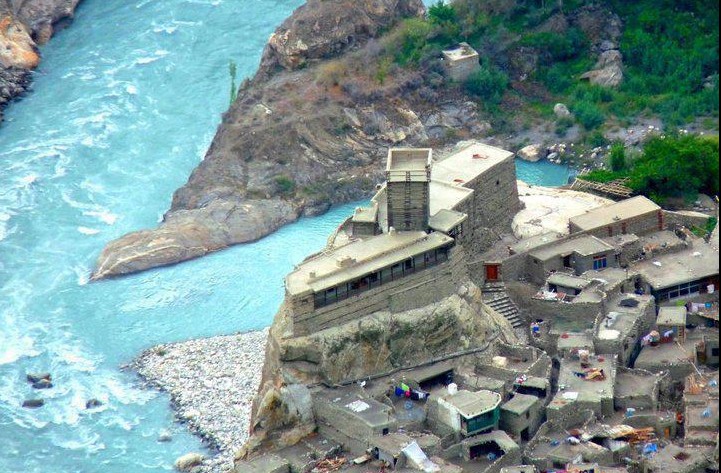
Altit Fort, located in the Hunza Valley, is a 900-year-old fortress that stands as a testament to the region’s rich history and architectural prowess. Originally built as a defensive stronghold and royal residence, the fort features stunning stonework and traditional Balti design.
The Aga Khan Trust for Culture restored Altit fort preserving its original structure with modern techniques. This effort has made the fort beacon of cultural heritage for future generations and revitalized the surrounding community.
A renowned aspect of the fort is its Royal garden known as the Kha Basi which translates to the “place of rest” ,along with the vibrant communities that contribute to the fort’s lively atmosphere. The elderly ladies sit in their colonial homes, dressed in traditional attire and converse with one another.
4. Eagle Nest Sunrise And Sunset

Eagle’s Nest is an ideal spot for sunrise and sunset, where the sky’s colours blend beautifully with the snow-capped mountains located in Duikar in the Hunza valley. Perched at an elevation of around 2,850 meters (9,350 feet), popular spot for both tourists and photographers seeking breath taking sunrise and sunset vistas.
The viewpoint also provides a unique perspective of the Hunza Valley, with its terraced fields and traditional villages, making it a must-visit destination for nature lovers and adventure seekers alike.
Eagle’s Nest Viewpoint is accessible by a steep, winding road from Karimabad, adding a sense of adventure to the journey.
The area around the viewpoint also offers opportunities for hiking and trekking, with several trails leading to nearby villages and scenic spots.
For those who are looking to stay overnight there are guest houses and hotels in Duiker, providing comfortable accommodations with incredible views.
5. Attabad Lake Hunza Valley
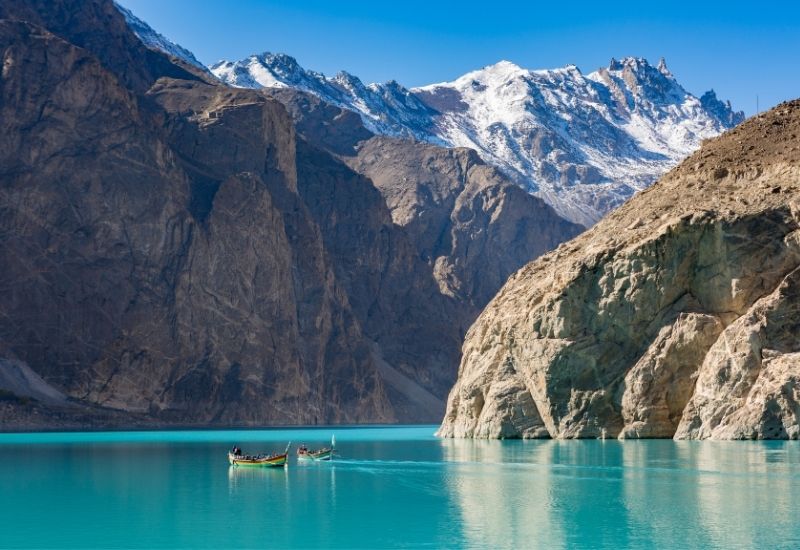
Attabad lake was formed in january 2010 due to a massive landslide that blocked the flow of Hunza river creating a natural Dam. The disaster resulted in significant loss of life and displacement of local communities but the lake has become one of the region’s most popular tourist destinations. Visitors to the lake often enjoy boating on its serene water.
Popular activities include boating, fishing, and jet skiing, offering both adventure and tranquility. The lake’s striking turquoise-blue colour is due to the glacial meltwater and the minerals suspended in the water, which give it its vivid hue.
The lake’s vibrant blue waters and breathtaking scenery make it a popular spot for photographers and nature lovers. It is Among Pakistan’s best lakes due to its beauty.
6. Passu Cones

The cones, with their sharp, serrated edges, are particularly captivating at sunrise and sunset when they are bathed in golden light “The Passu Cones”, also known as Passu Cathedral, are a series of striking, pointed peaks located in the Hunza Valley of Gilgit-Baltistan. These natural wonders rise dramatically from the Karakoram Range, creating a breath taking and unique landscape.
They lie along the Karakoram Highway, providing stunning views.
Passu Cones offer numerous trekking and hiking opportunities. These trials offer a chance to experience the rugged beauty of karakoram range up close.
7. Passu Glacier

Passu glacier is situated near the village of Passu in Hunza Valley within the Karakoram range. The glacier is known for its rugged beauty with ice formations and crevasses that create a striking contrast against the surrounding mountains .
The glacier’s surface is marked by sharp ridges and deep fissures adding to its dramatic appearance.
The area around the glaciers offers excellent trekking opportunities. The hikes provide stunning vistas of the glacier, the Passu cones and the surrounding peaks.
Ice formations, combined with the dramatic backdrop of towering peaks of Passu glacier make a must visit destination for nature enthusiasts.
8. Upper Hunza valley(Gulmit Village)

A picturesque village Gulmit is located in the Gojal valley of Gilgit Baltistan surrounded by majestic peaks and lush green fields, it offers a serene retreat in the heart of the Karakoram range.
The village is known for its dramatic scenery including views of Passu cones and the surrounding mountains. The nearby Attabad lake adds to the area’s natural beauty.
The village features historic landmarks such as the 700-year old Ondra fort and traditional Wakhi stone houses.
The mountains and peaks of Gulmit, combined with its historic monuments and pleasant climate, provide a perfect destination for tourists.
9. Hussaini Suspension Bridge
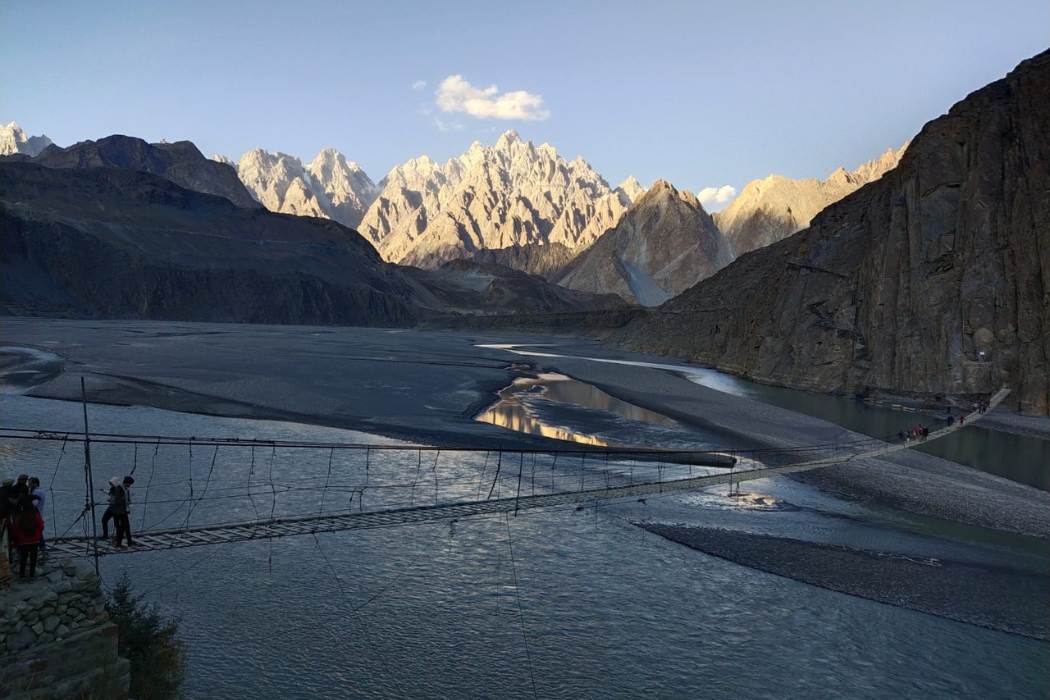
The Hussaini Suspension Bridge in Hunza Valley is one of the world’s most thrilling and precarious bridges. Six cables are hung on one side and four cables are on another side. This bridge is constructed from wooden planks and steel cables, with wide gaps between the planks that add to the adrenaline rush. The highest and best bridge of the world is Pakistan suspension bridge. Crossing the bridge provides breath taking views of surrounding mountains and the river below make it a favourite spot for visitors. If you really want to experience bridge walking at its best you can make a full day trek across Hussaini Bridge through Zarabad.
10. Rainbow Adventure Bridge
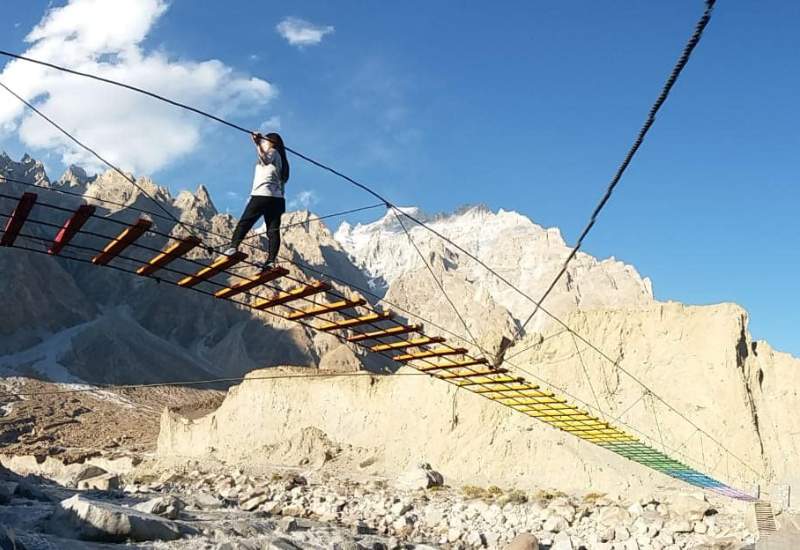
The Rainbow Bridge in Hunza Valley is a captivating modern suspension bridge known for its vibrant, colourful design. Spanning a picturesque gorge, the bridge offers stunning views of the lush valley and flowing river below. Its robust design guarantees safety while delivering an exciting experience for visitors.
The picturesque and vivid colours of bridge setting make it a popular destination for adventures and photography.
11. Khunjerab Pass

The Khunjerab is a lofty crossing point in the Karakoram mountains, located at the boundary between Pakistan and China. It links Pakistan’s Gilgit-Baltistan area with China’s Xinjiang territory. The pass stands at an altitude of roughly 4,693 meters (15,397) feet.
Khunjerab Pass, located at the end of the Pak-china economic corridor( CPEC) is essential for educational and economic growth. It generates employment, facilitates commerce and fosters scholarly interactions.
Gilgit-Baltistan’s border offers unforgettable experiences with stunning landscapes, rich culture, and adventurous activities like yak riding. A photographer’s paradise, the pass features breath-taking peaks and glaciers. Nearby Khunjerab National Park hosts wildlife like the snow leopard and Himalayan ibex.
Home to the Wakhi and Hunza people, the pass offers a rich tapestry of traditions and serves as a cultural exchange hub, strengthening ties between Pakistan and China.
The summer is the optimal period for visit, featuring comfortable temperatures and accessible roads.
12. Khunjerab National Park

Khunjerab National Park, a breath-taking nature preserve in the Gilgit-Baltistan region of Pakistan, is best experienced through a scenic drive. As the last destination in Hunza before reaching the Khunjerab Border, this park offers a unique journey to the highest paved international border crossing in the world, connecting Pakistan to China at an astonishing altitude of 4,706 meters (15,439 feet). Driving through the park, you’ll be immersed in stunning landscapes and may even spot majestic ibex, sturdy yaks, and playful marmots in their natural habitat. A visit to Khunjerab National Park is an unforgettable adventure, showcasing the raw beauty and wildlife of Pakistan.
13. Borith Lake

Just a 10-minute drive from Gulmit village lies the serene Borith Lake, an ideal retreat from the hustle and bustle of daily life in Hunza. Nestled in the western part of the lake, this picturesque spot offers unparalleled tranquillity. In the vicinity, you can discover both white and black glaciers, reachable by a 15 to 30 minutes or a 1 to 3-hour walk. Hunza, renowned for its stunning landscapes and recreational opportunities, makes camping at Borith Lake a must-do experience. Whether you’re seeking relaxation or adventure, Borith Lake is the perfect destination to unwind and immerse yourself in nature’s beauty.
14. Ondra Poygah (Hiking site)

Experience the charm of history at an ancient 1,500-year-old settlement, savour local delicacies, and conquer the longest staircases in Pakistan in the breath-taking valley of Gulmit. Known as one of the most beautiful valleys in the country, Gulmit has long been celebrated as a mountain resort, enchanting visitors for centuries. Nestled in the spectacular Karakoram mountains along the historic Silk Route, this extraordinary hotel offers an unforgettable stay. Located just 140 kilometres from Gilgit, 45 kilometres from Karimabad Hunza, and 136 kilometres from Khunjerab, it serves as the perfect base for exploring the region’s rich heritage and stunning landscapes.
15. Hoper Valley

Nestled in the heart of Nagar, Hopper valley is only just 10 kilometres away from Nagar Khas, the capital town of Nagar valley. Perched at an altitude of 8,000 feet (2,438 meters) in the Himalayan region, this valley is one of the most scenic and breath taking destinations.
From Karimabad, embark on a trek to the unique grey-black Hoper Glacier, a journey that takes about 40 to 45 minutes. The valley boasts two charming hotels, surrounded by nature’s beauty.
Hoper valley hosts Glaciers, The Rush lake and the hopper glacier. Five picturesque villages are also encompasses in the Valley.
For those seeking adventure ,trekking from Hopper to Skardu provides an unforgettable experience. Among the valley’s attractions, the lush lake stands out as a popular destination, drawing tourists with its serene beauty.
16. Ganesh Ancient Village

Ganish Village, honoured with a UNESCO Asia Pacific Heritage Award for its restoration, offers a unique glimpse into Hunza life, distinct from the traditional lifestyle seen at Baltit Fort. This charming village is home to beautifully carved wooden mosques, 100 to 200 years old, nestled behind a serene tank. According to legend, Ganish warriors practiced river-crossing techniques in this tank before attacking Nagar villages.
A fascinating tradition practiced still today involves using glacier meltwater for food storage. Butter encased in birch bark can be kept submerged in water for years and can even be transformed into sweets. Despite its award-winning restoration, Ganesh remains a living village, not just a museum.
A striking example of its living heritage is the massive Imamia complex under construction, featuring wooden carvings to blend with the village’s aesthetic. Visitors are welcome to explore; if the admission booth is unattended, simply enter the village and someone will guide you.
17. Shimshal Valley
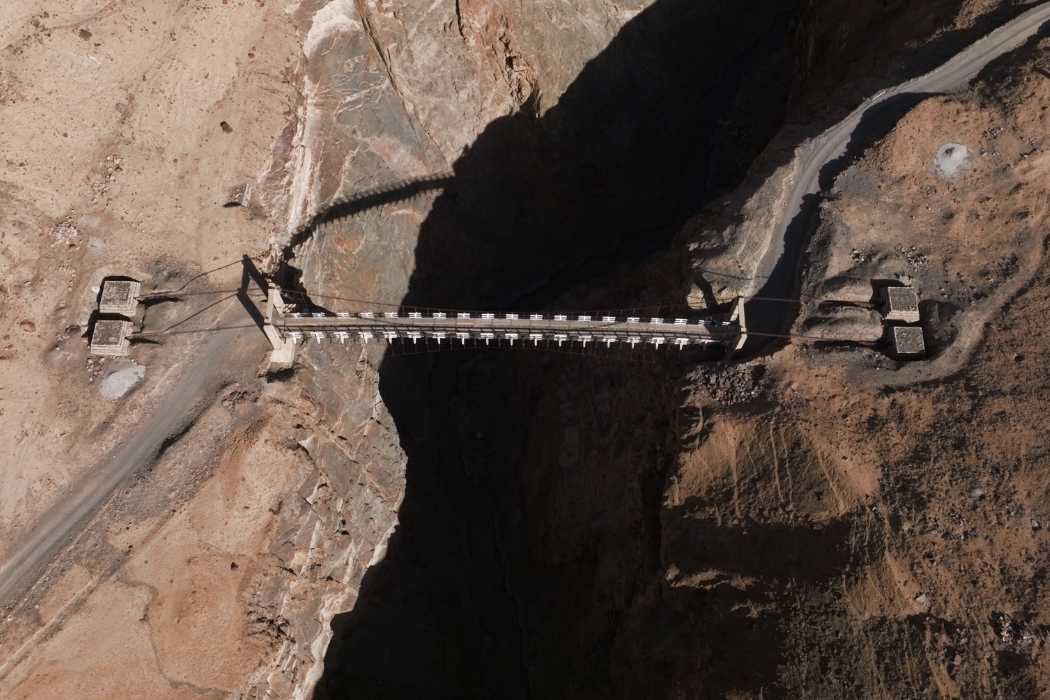
Shimshal Valley, often dubbed the “Valley of Climbers,” is a gem in the Hunza Valley, located in the Gojal region. Perched at over 3,100 meters above sea level, it is a haven for climbers and adventurers. It serves as a major tourist attraction in Hunza. It’s a village between China and Hunza about 55 kilometres from Passu village.
Shimshal Valley offers visitors a unique blend of adventure and serenity. It is home to the largest adventure area in Hunza, attracting thrill-seekers from around the globe.
Visitors to Shimshal can immerse themselves in the local culture, enjoy traditional hospitality, and explore the stunning natural beauty. With its pristine environment, clear skies, and vibrant communities, Shimshal Valley is not just a destination but an unforgettable experience for all who venture there.
18. Chupursan valley
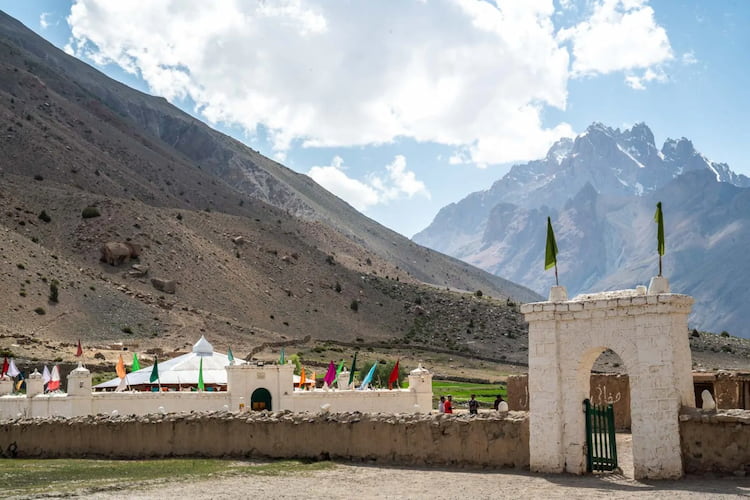
Chapursan valley, among the most captivating locations in Pakistan, offers a breath taking mix of vivid reds, otherworldly scenery, and genuine “top-of-the-world” ambiance .While other valleys may share some of its qualities, none capture the unique magic of Chapursan Valley. Situated thousands of meters above sea level, its scenery often makes visitors feel like they are on top of the world.
Located in one of the most remote parts of Gilgit-Baltistan, Chapursan Valley is accessible only by jeep or motorbike along a rugged, bumpy road. Internet access is nearly non-existent, and the majority of the valley’s residents speak Wakhi. Although Chapursan valley is becoming more well-known, it continues to its remote setting. Limited information about this charming village adds to the adventure of getting there.
Visitors to Chapursan Valley can expect to be captivated by its pristine beauty, serene environment, and the warm hospitality of its residents. It is a place where the majesty of nature and the simplicity of life combine to create an unforgettable experience.
19. Misgar Valley

Misgar, the final village in the Gojal valley, is situated about 7 km north of Sost along the Misgar link road which branches off from the Karakoram Highway. Nestled in one of Gilgit-Baltistan’s most stunning and geographically significant areas, Misgar Valley serves as a key point where the China-Pakistan border passes through the Mintaka Pass.
The valley is traversed by three main rivers—Kilik, Mintaka, and Dilsung—which extend into China and Afghanistan, adding to the region’s strategic importance. A highlight of Misgar is the British fort built in 1932, situated about five kilometers upstream from the valley, offering historical and architectural intrigue.
Misgar Valley is a haven for adventurers and nature lovers, boasting breath-taking landscapes and rich cultural heritage. Its remote location ensures a tranquil and unspoiled environment, perfect for those seeking solitude and connection with nature. The warm hospitality of the local Wakhi-speaking community adds to the charm of this hidden gem, making it a must-visit destination in the Gilgit-Baltistan region.
20. Boiber Valley

Shimshal was historically connected to Gojal through the valleys of Piryar, Boiber and Avgarch providing a route to Karakoram highway in the Moorkhun valley. For many years, access to Shimshal Valley was through the 5,000m high Qaroon Pass, involving a challenging trek from Jamalabad across footbridges and steep slopes.
The 2015 flood disaster severely damaged a well-built local road, leaving Shimshal feeling like a secluded retreat. The Wakhi communities, constructed from raw stone and wood, are some of the world’s oldest. The locals have intriguing tales about these ancient ruins.
The east-west Boibar Valley features a river flowing to the Hunza River, starting at Qarn Koh (7,164m), and is historically significant as the original Kuchi settlement in Gojal and gateway to Shimshal.


Comment (0)